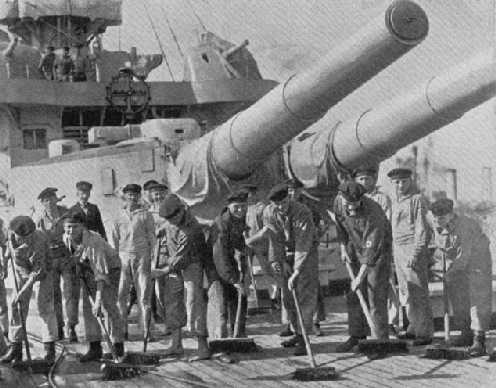| Type |
Separate |
| Projectile Types and Weights |
World War I
AP L/2,6 - 529 lbs. (240
kg)
HE L/2,9 base fuze - 529
lbs. (240 kg)
World War II
HE L/4,3 base fuze - 529
lbs. (240 kg)
HE L/4,1 nose fuze - 529
lbs. (240 kg)
HE L/4,4 base and nose fuze
- 626 lbs. (284 kg) |
| Bursting Charge |
N/A |
| Projectile Length |
AP L/2,6 - 29.0 in (73.6 cm)
HE L/2,9 base fuze - 32.3 in (82.1 cm)
HE L/4,3 base fuze - 47.4 in (120 cm)
HE L/4,1 nose fuze - 45.2 in (115 cm)
HE L/4,4 base and nose fuze - 49.0 in
(124.5 cm) |
| Propellant Charge |
World War I: About 161 lbs. (73
kg) RPC 12
World War II: 154.3 lbs. (70 kg)
RPC 38 |
| Muzzle Velocity |
AP L/2,6 - 2,690 fps (820 mps)
HE L/4,3 - 2,690 fps (820 mps)
HE L/4,1 - 2,690 fps (820 mps)
HE L/4,4 - 2,428 fps (740 mps) |
| Working Pressure |
20.3 tons/in2 (3,200
kg/cm2) |
| Approximate Barrel Life |
N/A |
| Ammunition stowage per gun |
Braunschweig and Deutschland: 85
rounds |
| Notes:
1) The AP L/2,6 was about 2crh.
2) Actual Projectile designations were
as follows:
AP L/2,6 - Psgr. L/2,6
HE L/2,9 base fuze - Spr.gr.
L/2,9 Bdz
HE L/4,3 base fuze - Spr.gr.
L/4,3 Bdz (mhb)
HE L/4,1 nose fuze - Spr.gr.
L/4,1 Kz (mhb)
HE L/4,4 base and nose fuze
- Spr.gr. L/4,4 Bdz u. Kz (mhb) |
